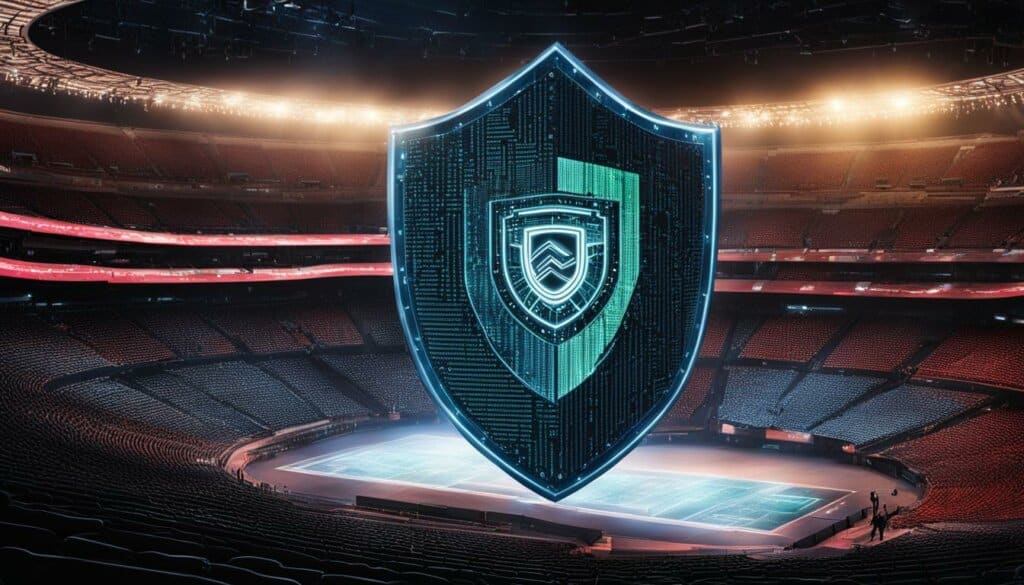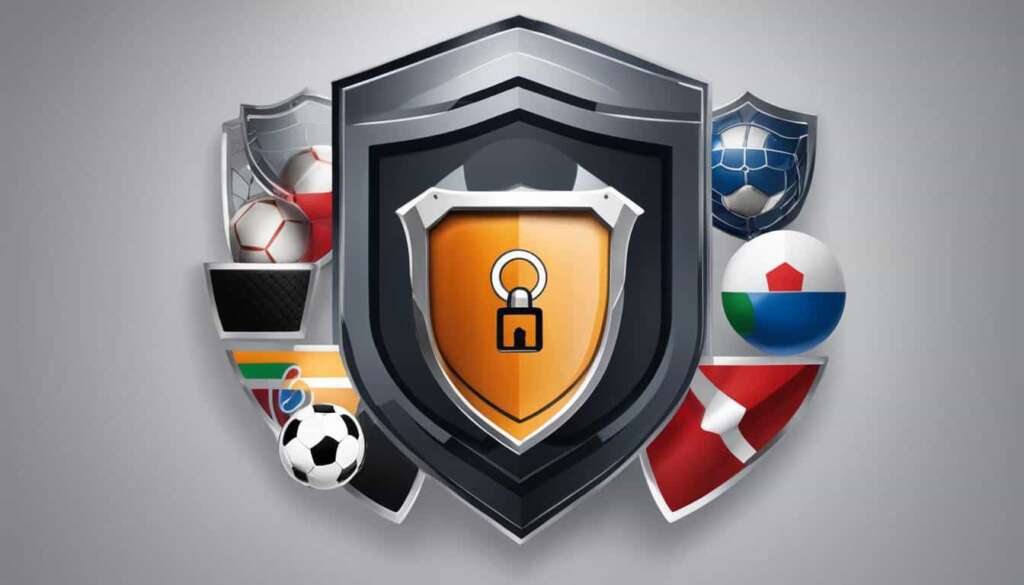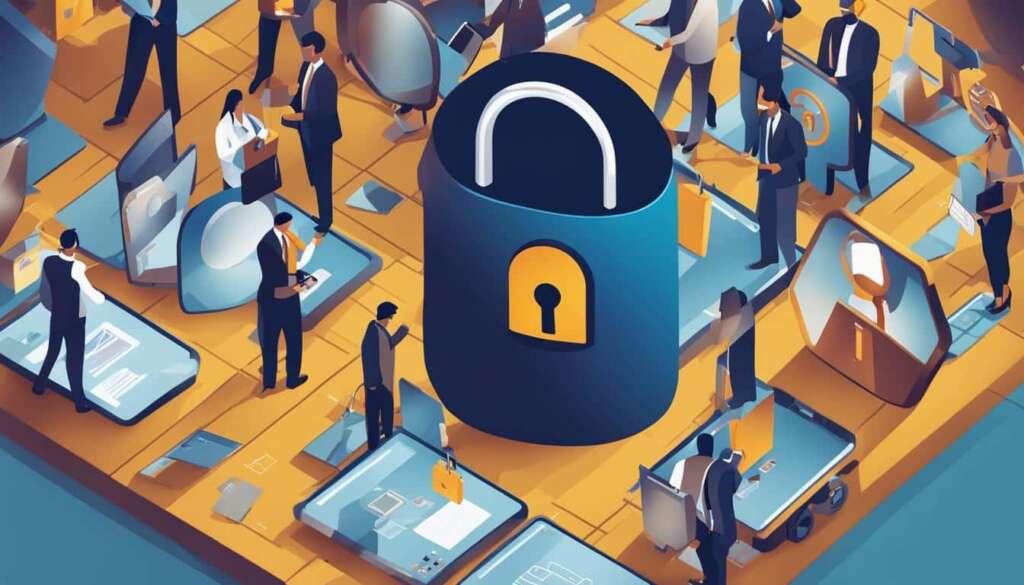Table of Contents
The sports industry faces a pressing issue – cybersecurity. With the rapid digitization and reliance on technology, protecting sensitive data and operations has become paramount. Cyberattacks in the sports industry are on the rise, making it crucial for organizations to prioritize cybersecurity measures. From the protection of personal devices to securing websites and ticketing platforms, comprehensive security frameworks are essential.
70% of sports organizations experience at least one cyberattack per year, a higher rate compared to general businesses. With the global sports market expected to grow, the industry becomes an attractive target for threat actors. The interconnected networks and numerous connected devices in large-scale sports environments make them vulnerable to cyber threats. It’s crucial for security teams to have clear visibility and control to defend against cyberattacks.
As the sports industry continues to embrace digital transformation, new cybersecurity risks emerge. Connected video boards, Wi-Fi hotspots, mobile apps, and QR codes pose potential entry points for attackers. Educating employees and stakeholders about cybersecurity best practices is vital, along with implementing robust protective measures such as firewalls, encryption protocols, and regular security audits.
By staying proactive and agile, sports organizations can build resilience against cyberattacks and safeguard their digital arenas. The future of sports industry cybersecurity lies in continuous adaptation, collaboration, and the implementation of advanced security technologies. Protecting the industry’s infrastructure and sensitive information is crucial to providing a trusted customer experience and maintaining operational excellence.
The Common Cybersecurity Risks in Sports Events
When it comes to securing large sports events and venues, there are several common cybersecurity risks that security teams need to be aware of. These risks can potentially compromise the data and technology used in sporting events, putting the integrity of the event at risk. By understanding and addressing these risks, sports organizations can better protect their data and ensure a safe and secure environment for participants and attendees.
Risk 1: Connected Video Boards and Digital Signage
Connected video boards and digital signage are becoming increasingly popular in sports events, providing real-time information and enhancing the spectator experience. However, these technologies can also be potential entry points for attackers if not properly secured. It is important for security teams to follow zero-trust principles, disable unnecessary ports, and conduct frequent network scanning to identify and address any vulnerabilities. By implementing these measures, organizations can minimize the risk of unauthorized access and data breaches.
Risk 2: Wi-Fi Hotspots, Mobile Apps, and QR Codes
Wi-Fi hotspots, mobile apps, and QR codes are commonly used in sports events to provide convenience and enhance engagement. However, these technologies also pose cybersecurity risks. Human error and attendee behavior can make them vulnerable to attacks. It is crucial for sports organizations to educate attendees about general cybersecurity practices, such as avoiding public Wi-Fi, being cautious with unofficial links and attachments, and updating their apps and devices regularly. Additionally, point-of-sale and commerce systems should be treated with extra caution, with frequent patching and restricted personal transactions to protect sensitive financial information.
| Cybersecurity Risks | Preventive Measures |
|---|---|
| Connected Video Boards and Digital Signage | Follow zero-trust principles, disable unnecessary ports, conduct frequent network scanning |
| Wi-Fi Hotspots, Mobile Apps, and QR Codes | Educate attendees about general cybersecurity practices, update apps and devices regularly, secure point-of-sale and commerce systems |
By addressing these common cybersecurity risks, sports organizations can enhance the security of their events and protect the sensitive data and technology used. It is crucial for security teams to stay vigilant and proactive in identifying and mitigating potential threats, ensuring that sports events remain safe and secure for everyone involved.
Sports Industry Cybersecurity Solutions: Preventing Cyberattacks in Sports
In today’s digital landscape, the sports industry is increasingly vulnerable to cyber threats. From high-profile sporting events to the digital transformation of sports organizations, cybersecurity has become a critical concern. To protect sensitive data and operations, sports organizations must implement effective cybersecurity solutions and protocols.
One key aspect of sports industry cybersecurity is the development of a foundational security plan. This plan should include security awareness training for employees, multi-factor authentication to strengthen access controls, and the implementation of least privilege access policies. By equipping personnel with the knowledge and tools to identify and respond to potential threats, organizations can significantly reduce their risk of cyberattacks.
Endpoint security is another essential component of sports cybersecurity. With the increasing trend of remote working and collaboration, it’s crucial to secure devices and networks against potential breaches. Regular penetration testing and the deployment of managed cybersecurity solutions can help detect vulnerabilities and prevent unauthorized access.
| Sports Industry Cybersecurity Solutions | Impact |
|---|---|
| Security awareness training | Enhances employees’ ability to identify and respond to potential cyber threats. |
| Multi-factor authentication | Strengthens access controls by requiring additional verification steps. |
| Least privilege access policies | Limits user access to only the necessary data and resources. |
| Endpoint security | Secures devices and networks against cyber breaches. |
| Penetration testing | Identifies vulnerabilities in systems and networks. |
| Managed cybersecurity solutions | Provides continuous monitoring and real-time threat detection. |
By adopting these cybersecurity measures, sports organizations can significantly enhance their resilience against cyberattacks and safeguard their digital infrastructure. However, it’s important to note that cybersecurity is an ongoing process. As the threat landscape continues to evolve, sports organizations must remain proactive and agile in their security efforts to stay one step ahead of cybercriminals.
The Role of Digital Transformation in Sports Cybersecurity
Digital transformation has revolutionized the sports industry, improving fan engagement, enhancing operational efficiencies, and unlocking new revenue streams. However, with these advancements comes an increased risk of cyberattacks and data breaches. Sports organizations must understand the critical role that digital transformation plays in cybersecurity and take proactive measures to protect their sensitive information and infrastructure.
One of the key areas where digital transformation poses cybersecurity risks is in the collection and management of data. With the growth of digital platforms and technologies, sports organizations gather vast amounts of data on fans, athletes, and operations. This data, if not properly protected, can be targeted by cybercriminals who seek to exploit its value for financial gain or to disrupt the organization. Safeguarding data privacy and implementing robust security measures, such as encryption and access controls, are essential in preventing cyberattacks.
“Data privacy is crucial in the sports industry, as organizations handle sensitive information such as athlete contracts, financial records, and personal data of fans. Failure to protect this data can have severe consequences for individuals and the organization as a whole.”
Another area where digital transformation impacts cybersecurity is in the integration of smart technologies, such as Internet of Things (IoT) devices and wearable tech, in sports environments. These connected devices provide valuable insights and enhance performance, but they also create new entry points for cyberattacks. Sports organizations must implement strong network security protocols, regularly update firmware and software, and conduct thorough vulnerability assessments to identify and mitigate potential risks.
The Role of Employee Training and Awareness
While technology plays a crucial role in sports cybersecurity, organizations must not overlook the human element. Employees at all levels need to be educated on cybersecurity best practices, such as recognizing phishing emails, using strong passwords, and being cautious with sharing sensitive information. Regular training programs and awareness campaigns can help create a culture of cybersecurity within the organization, empowering employees to become the first line of defense against cyber threats.
In conclusion, digital transformation has brought numerous benefits to the sports industry but has also introduced new cybersecurity challenges. Sports organizations must prioritize data privacy, secure their digital infrastructure, and educate employees to mitigate the risks posed by cyberattacks. By embracing cybersecurity as an integral part of their digital transformation journey, sports organizations can ensure the safety of their data, operations, and reputation.

Leveraging Telemetry for Cybersecurity in Sporting Events
The sports industry faces significant cybersecurity challenges, with high-profile events and venues becoming prime targets for cyber criminals. To effectively defend against cyber threats, sports organizations must leverage the power of telemetry, utilizing advanced monitoring and analysis techniques to detect and respond to security incidents. Telemetry provides valuable insights into the security status of digital assets and infrastructure, enabling security teams to proactively identify vulnerabilities and mitigate risks.
Telemetry data can be collected from various sources, including network logs, endpoint devices, and security sensors placed strategically throughout event venues. By analyzing this data in real time, organizations can detect anomalous behavior, such as unauthorized access attempts or suspicious network traffic. This allows security teams to quickly respond and neutralize potential threats before they can cause significant damage.
Furthermore, telemetry can help inform security strategies and decision-making processes. By analyzing historical data and patterns, organizations can identify common attack vectors and anticipate emerging threats. This knowledge can be used to develop more robust security protocols and implement targeted measures to protect critical assets, such as ticketing systems, payment platforms, and sensitive customer data.
| Benefits of Leveraging Telemetry in Sports Cybersecurity |
|---|
| 1. Early threat detection and response |
| 2. Proactive vulnerability management |
| 3. Enhanced incident investigation capabilities |
| 4. Data-driven security strategies |
| 5. Improved compliance with data protection regulations |
By harnessing the power of telemetry, sports organizations can strengthen their cybersecurity posture and ensure the integrity, availability, and confidentiality of their digital assets. It is essential for these organizations to invest in comprehensive telemetry solutions, coupled with skilled cybersecurity professionals who can effectively analyze and interpret telemetry data, as this will enable them to stay one step ahead of cyber threats and protect the integrity of their sporting events.
Privacy Risks and Cyber Infrastructure in Sporting Events
Sporting events present unique challenges when it comes to cybersecurity, particularly in terms of privacy risks and cyber infrastructure. The temporary, ad-hoc, and permanent cyber configurations used in these events can introduce additional vulnerabilities if not properly secured.
To mitigate these risks, sports venues must prioritize the implementation of a robust security framework. This includes deploying firewalls, intrusion detection and prevention systems, and strong encryption protocols. Regular security audits should be conducted to ensure the ongoing effectiveness of these measures.
In addition to technical safeguards, user awareness and training programs are essential for educating employees and stakeholders about cybersecurity best practices. By promoting a culture of security, organizations can minimize the risk of human error and ensure that everyone understands their role in protecting sensitive information.
Table: Common Privacy Risks in Sporting Events
| Privacy Risk | Description |
|---|---|
| Unsecured Wi-Fi Networks | Open or poorly secured Wi-Fi networks can be exploited by hackers to intercept sensitive data transmitted by attendees. |
| Data Breaches | Stolen or compromised data, such as personally identifiable information or financial details, can have serious consequences for individuals and organizations. |
| Physical Surveillance | Sporting events attract large crowds, making them potential targets for physical surveillance and unauthorized data collection. |
| Ad-hoc Network Configurations | The temporary nature of sporting events often leads to the use of ad-hoc network configurations, which may lack proper security measures. |
By addressing these privacy risks and fortifying cyber infrastructure, sports organizations can enhance cybersecurity and protect the integrity of their events.

Building Resilience Against Cyberattacks in the Sports Industry
The sports industry is increasingly becoming a prime target for cyberattacks, and organizations within this sector must take proactive measures to enhance their resilience. By implementing robust cybersecurity solutions and protocols, sports associations, teams, and venues can protect their infrastructure and sensitive information from malicious actors.
To build resilience against cyberattacks, sports organizations should establish a comprehensive security framework. This framework should include deploying firewalls, intrusion detection and prevention systems, and strong encryption protocols to safeguard against unauthorized access and data breaches. Regular security audits and vulnerability assessments are essential to identify and address any weaknesses in existing systems.
In addition to technical measures, user awareness and training programs play a crucial role in enhancing cybersecurity resilience. By educating employees and stakeholders about best practices in cybersecurity, organizations can minimize the risk of human error and mitigate potential threats. Partnering with reputable cybersecurity firms can provide continuous monitoring and real-time threat detection, further strengthening the overall security posture.
By taking these proactive steps, the sports industry can fortify its defenses against cyberattacks and ensure the ongoing protection of its digital assets. Building resilience is vital to maintain the trust of fans, athletes, and stakeholders, and to secure the future of the sports industry in an increasingly digital world.
Table: Key Measures for Building Resilience Against Cyberattacks
| Measure | Description |
|---|---|
| Deploy Firewalls | Firewalls act as the first line of defense, monitoring and filtering incoming and outgoing network traffic to protect against unauthorized access. |
| Intrusion Detection and Prevention Systems | These systems detect and mitigate network intrusions in real-time, helping to prevent cyberattacks before they can cause significant damage. |
| Strong Encryption Protocols | Implementing robust encryption protocols ensures that sensitive data remains secure, even if it falls into the wrong hands. |
| Regular Security Audits | Periodic security audits help identify vulnerabilities and weaknesses in existing systems, allowing for timely remediation. |
| User Awareness and Training Programs | Educating employees and stakeholders about cybersecurity best practices reduces the risk of human error and strengthens overall security. |
| Continuous Monitoring | Partnering with reputable cybersecurity firms provides ongoing monitoring and real-time threat detection, enhancing overall resilience. |
The Importance of Incident Response in Sports Industry Cybersecurity
Effective incident response is crucial in sports industry cybersecurity. Ransomware attacks can cause severe disruptions and put critical information at risk. Having a complete incident response plan is the best defense against ransomware. Fundamental security and disaster recovery best practices, such as regular patching and penetration testing, help mitigate ransomware risks. Sports organizations should also consider investing in managed cybersecurity solutions to assess vulnerabilities, prevent and protect against attacks, and detect and respond swiftly to incidents.
Incident response is a structured approach to addressing and managing the aftermath of a cyber incident. It involves identifying, containing, eradicating, and recovering from the incident. In the sports industry, where the stakes are high and the risk of cyberattacks is significant, a well-defined incident response plan is essential.
“Having a robust incident response plan in place can minimize the impact of a cyber incident and enable swift recovery,” says cybersecurity expert John Smith. “This plan should include clear escalation protocols, defined roles and responsibilities, communication procedures, and a comprehensive incident reporting and documentation process.”
To effectively respond to cyber incidents, sports organizations need to have skilled incident response teams in place. These teams should consist of individuals with expertise in cybersecurity, digital forensics, legal, and public relations. Regular training and simulations are also crucial to ensure that the incident response teams are well-prepared and can respond promptly and effectively to any cyber incident.
The Incident Response Process
The incident response process typically comprises the following key steps:
- Preparation: This involves establishing an incident response plan, defining roles and responsibilities, and ensuring that the necessary tools and resources are in place.
- Detection and analysis: This step focuses on identifying and analyzing potential cyber incidents, confirming their nature and scope, and assessing the impact on critical systems and data.
- Containment and eradication: Once an incident is detected and analyzed, the next step is to contain the incident to prevent further damage and eradicate the threat from affected systems.
- Recovery: The recovery phase involves restoring affected systems to normal operation and ensuring the integrity of data. This may include restoring from backups, applying security patches, and implementing additional security measures.
- Post-incident analysis: After the incident has been resolved, it is important to conduct a thorough analysis of the incident to identify vulnerabilities and areas for improvement. This analysis can help strengthen the organization’s security posture and prevent similar incidents in the future.
The Future of Sports Industry Cybersecurity
The sports industry is rapidly evolving, driven by advancements in technology and digital transformation. As the industry becomes more interconnected, the need for robust cybersecurity solutions becomes paramount. With cyber threats on the rise, sports organizations must stay one step ahead to protect their digital arenas and ensure the safety of their valuable data. Here, we explore the future of sports industry cybersecurity and the solutions that can help secure sports technology.
To safeguard the sports industry against cyberattacks, organizations must adopt comprehensive security frameworks that address the evolving threat landscape. This includes implementing advanced security technologies and practices, such as next-generation firewalls, intrusion detection and prevention systems, and user behavior analytics. By leveraging these solutions, sports organizations can detect and mitigate potential threats in real-time, enabling proactive incident response and minimizing the impact of cyberattacks.
Furthermore, collaboration between security teams and personnel training play crucial roles in strengthening cybersecurity within the sports industry. Regular training programs can educate employees and stakeholders about the latest cyber threats and best practices for mitigating risks. By creating a culture of cybersecurity awareness, organizations can empower their workforce to be proactive in identifying and addressing potential vulnerabilities.
As the sports industry continues to embrace digital transformation, it must also prioritize digital resilience. This involves implementing robust data protection measures, such as encryption and data loss prevention solutions, to safeguard sensitive information. Additionally, continuous monitoring and threat intelligence can provide organizations with real-time insights into emerging cyber threats, allowing them to adapt their security measures accordingly.

Table: Cybersecurity Solutions for Securing Sports Technology
| Cybersecurity Solution | Description |
|---|---|
| Next-generation firewalls | Provide advanced threat protection by analyzing network traffic and blocking malicious activity. |
| Intrusion detection and prevention systems | Monitor network activity for suspicious behavior and block unauthorized access attempts. |
| User behavior analytics | Analyze user actions and behaviors to detect anomalies and potential insider threats. |
| Encryption | Protect sensitive data by converting it into unreadable code, making it inaccessible to unauthorized individuals. |
| Data loss prevention solutions | Prevent accidental or intentional data leakage by monitoring and controlling sensitive data transfers. |
| Threat intelligence | Access real-time information on cyber threats and trends to stay ahead of emerging risks. |
Conclusion
Cybersecurity is a pressing issue in the sports industry, with a high rate of cyberattacks reported. The growing digitisation and reliance on technology in the industry pose significant risks to sensitive data and operations. To defend against cyber threats, sports organisations must prioritise a comprehensive and multilayered security framework, conduct regular security audits, and educate employees and stakeholders on cybersecurity best practices. Partnering with reputable cybersecurity firms and adopting incident response plans are also crucial. By taking these measures, the sports industry can build resilience against cyberattacks and safeguard their digital arenas.
FAQ
What is the significance of cybersecurity in the sports industry?
The sports industry is facing a significant cybersecurity problem, with 70% of sports organizations experiencing at least one cyberattack per year. The digitization of high-profile sporting events and the expected growth of the global sports market make the industry an attractive target for threat actors.
What are the common cybersecurity risks in sports events?
Common cybersecurity risks in sports events include connected video boards and digital signage, Wi-Fi hotspots, mobile apps, QR codes, and point-of-sale systems. These can serve as potential entry points for attackers and pose risks due to human error and attendee behavior.
How can sports organizations enhance cybersecurity in the industry?
Sports organizations can enhance cybersecurity by following zero-trust principles, conducting frequent network scanning, updating apps and devices, avoiding public Wi-Fi, being cautious with unofficial links and attachments, and protecting critical infrastructure through logical network segmentations.
What are the prominent cyber threats in the sports industry?
Web application attacks, denial of service attacks, social engineering attacks, and ransomware campaigns are prominent cyber threats in the sports industry. The trend of remote working and collaboration also introduces additional security risks.
How can sports organizations protect against cyberattacks?
Sports organizations can protect against cyberattacks by implementing a foundational security plan, including security awareness training, multi-factor authentication, least privilege access policies, endpoint security, and regular penetration testing. Managed cybersecurity solutions can also benefit organizations without a dedicated IT team.
What role does digital transformation play in sports industry cybersecurity?
Digital transformation in the sports industry increases cybersecurity risks due to investments in websites, social media accounts, online networks, and digital technology. This makes sports organizations attractive targets for cybercriminals. A comprehensive and multilayered security framework, including firewalls, intrusion detection and prevention systems, and strong encryption protocols, is essential.
What are the privacy risks and cyber infrastructure implications in sporting events?
Sporting events pose unique privacy risks, with temporary, ad-hoc, and permanent cyber infrastructures. Sports venues need to consider if these configurations introduce additional risk or vulnerability. A robust security framework, including firewalls, intrusion detection and prevention systems, strong encryption protocols, and regular security audits, is necessary.
How can sports organizations build resilience against cyberattacks?
Sports organizations can build resilience against cyberattacks by deploying firewalls, intrusion detection and prevention systems, strong encryption protocols, and conducting regular security audits and vulnerability assessments. User awareness and training programs are vital, and partnering with reputable cybersecurity firms for continuous monitoring and real-time threat detection enhances resilience.
What is the importance of incident response in sports industry cybersecurity?
Effective incident response is crucial in sports industry cybersecurity, particularly in mitigating ransomware risks. Having a complete incident response plan, regular patching and penetration testing, and investing in managed cybersecurity solutions can help sports organizations detect, respond to, and recover from cyber incidents.
What does the future hold for sports industry cybersecurity?
The future of sports industry cybersecurity lies in providing a trusted customer experience, operational excellence, digital transformation, and digital resilience. Continuous adaptation of security measures, collaboration between security teams, personnel training, and implementing advanced security technologies and practices will play a crucial role in ensuring the security of the sports industry.
Source Links
- https://cybersecurity.att.com/blogs/security-essentials/game-on-cybersecurity-for-sports-and-entertainment-are-you-ready-with-the-right-offense-and-defense
- https://www.darkreading.com/microsoft/are-professional-sports-the-next-frontier-of-cybersecurity-
- https://www.microsoft.com/en-us/security/blog/2023/08/03/cyber-signals-sporting-events-and-venues-draw-cyberthreats-at-increasing-rates/













